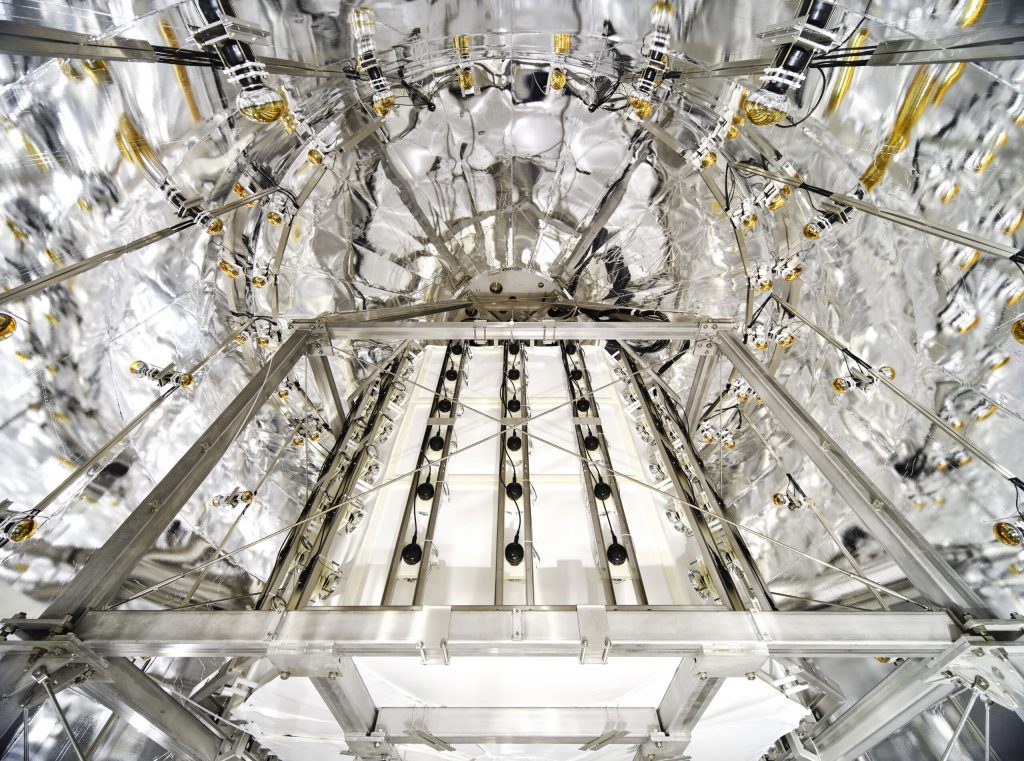[Research] First WIMP Search Results from the XENONnT
The XENON collaboration
Kobayashi-Maskawa Institute for the Origin of Particles and the Universe, Nagoya University (KMI)
Institute for Space-Earth Environmental Research, Nagoya University (ISEE)
Kavli Institute for the Physics and Mathematics of the Universe, The University of Tokyo (Kavli IPMU)
Institute for Cosmic Ray Research, The University of Tokyo (ICRR)
Graduate School of Science, Kobe University

Scientists from the international XENON collaboration, an international experimental group including the Kobayashi-Maskawa Institute for the Origin of Particles and the Universe (KMI), Nagoya University; the Institute for Space-Earth Environmental Research (ISEE), Nagoya University; the Kavli Institute for the Physics and Mathematics of the Universe (Kavli IPMU), The University of Tokyo; the Institute for Cosmic Ray Research (ICRR), The University of Tokyo; and the Graduate School of Science, Kobe University, announced today the first WIMP dark matter search results from XENONnT, the latest detector of the XENON Dark Matter program. The XENON collaboration reported new limits on interaction of WIMPs with ordinary matter, which significantly improved the previous limits reported by the predecessor experiment, the XENON1T, in 2018. This result was presented at the special colloquium at Special Issue of L’Aqiula Joint Astroparticle Collloquia, on 22:30 2023/03/22 Japan Standard Time.
For more detail, please visit press release by XENON Collaboration
From Nagoya University, Professor. Yoshitaka Itow (KMI, ISEE, IAR), Associate Professor. Shingo Kazama (KMI) and JSPS Research Fellowship for Young Scientists (PD) Masatoshi Kobayashi (ISEE) are involved in the collaboration.
Prof. Kazama, who led the data analysis as one of the Analysis Coordinators, commented;
I am glad to deliver the results on WIMP search which is our main physics goal. The XENONnT detector had to be operated with a very weak electric field compared to the design value due to a problem with the cathode electrode, which greatly affected particle identification, one of TPC’s strengths, and it took longer than expected to understand the detector response. This greatly affected particle identification, which is one of TPC’s strong points, and it took us longer than expected to understand the detector response.
The statistics obtained this time are still only 1/20 of our target, and we intend to make various upgrades such as electrode repair and addition of gadolinium to the neutron veto detector to achieve higher sensitivity in the search in the future. My role as the head of the analysis group ends here with the results of the WIMP search, and I will now focus on the realization of the future DARWIN experiment, which is my future plan, to elucidate the nature of dark matter and the physics behind it.
(Shingo KAZAMA, Associate Professor/KMI)
Dr. Kobayashi, who had been onsite for detector assembly in Italy since COVID-19 pandemic in 2020 and has been responsible for detector operation and data acquisition as one of Run Coordinators, and especially as one of the experts of xenon distillation system, commented;
We finally reported the WIMP search results, our most important physics target. Unfortunately, it did not result in the discovery of WIMPs, but we were able to proceed with the experiment even in the face of the global pandemic and obtain limits that much improves those of the predecessor XENON1T experiment.
I myself am very pleased to have been able to contribute, especially in terms of construction and commissioning of the detector and acquisition of physical data. As mentioned in the release, XENONnT continues to acquire data by further reducing the background noise of the detector. We will continue to analyze the data and upgrade the detector to reveal unknown physical phenomena such as the properties of dark matter and neutrinos.
(Masatoshi KOBAYASHI, JSPS Research Fellowship for Young Scientists, PD/ISEE)
The XENON collaboration is an international experimental group including Nagoya University, the University of Tokyo, and Kobe University from Japan.
Japanese groups are contributing for the gadolinium loaded water cherenkov based neutron veto system initially developed by Super-Kamiokande group; the liquid xenon purification system with the experience from the XMASS experiment; and data analysis as one of analysis coordinators.
*Our research related to XENON1T and XENONnT experiments are supported by: JSPS Kakenhi (18H03697, 18KK0082, 19H05802, 19H05805, 19H00675, 19H01920, 21H05455, 21H04466, 22H00127) , JSPS Core-to-Core program (JPJSCCA20200002), and JST FOREST JPMJFR212Q.
Paper details
- Title: First Dark Matter Search with Nuclear Recoils from the XENONnT Experiment
- Author: XENON Collaboration
- Preprint: xenonexperiment.org (Submitted to Physical Review Letters, will appear in arxiv.org shortly)
Glossary
XENON collaboration
An international alliance consisting of about 180 researchers from 27 institutions in 12 countries and regions, mainly in Europe, the United States, and Japan. Institutions from Japan include Nagoya University, the University of Tokyo, and Kobe University.
Weakly Interacting Massive Particle (WIMP)
As one of the candidates for subatomic dark matter, it is considered as yet-undiscovered particle of which interaction with matter is very weak and having heavy mass. Their masses, interactions or other detailed properties are not known. One of the leading candidates is a supersymmetric particle predicted by a supersymmetric standard model of particle physics.
Blind analysis
One of data analysis methods to eliminate any unconscious biases. Observed data in the region of interest are masked until all analysis tools are fully ready.



